Email Marketing Battle Royale: Constant Contact vs Klaviyo for Shopify

Choosing the Right Email Marketing Platform for Your Shopify Store
Quick Comparison: Top Email Marketing Platforms for Shopify
- Advanced Platform: Best for growing ecommerce businesses needing advanced segmentation, automation, and deep Shopify integration
- Entry-Level Platform: Better for beginners seeking simplicity, affordability, and basic ecommerce features
- Key Difference: Advanced platforms offer superior ecommerce-specific features and deeper Shopify integration, while entry-level solutions provide a more user-friendly experience at a lower entry point
When comparing email marketing platforms for Shopify, store owners face a critical decision that directly impacts their marketing success. Different platforms offer distinct advantages depending on your business size, technical expertise, and marketing goals.
Advanced ecommerce-focused platforms have established themselves as powerhouses, designed specifically for online retailers with features like advanced segmentation, pre-built automation flows, and deep Shopify integration. As one marketing expert noted in our research, “Sophisticated platforms are the clear winners for growing ecommerce businesses,” despite having a steeper learning curve.
Entry-level platforms, meanwhile, offer more approachable interfaces with intuitive design tools and simpler automation, making them ideal for smaller stores or those new to email marketing. Their strength lies in ease of use and affordability rather than advanced ecommerce capabilities.
For mid-sized Shopify merchants generating between $1-10 million in annual sales, this decision becomes especially important. The right platform can help break through sales plateaus by delivering personalized messaging that converts browsers into buyers.
Your choice ultimately depends on where your business stands today and where you want it to go tomorrow. Are you ready for sophisticated marketing automation with revenue tracking, or do you need a straightforward solution to get started quickly?
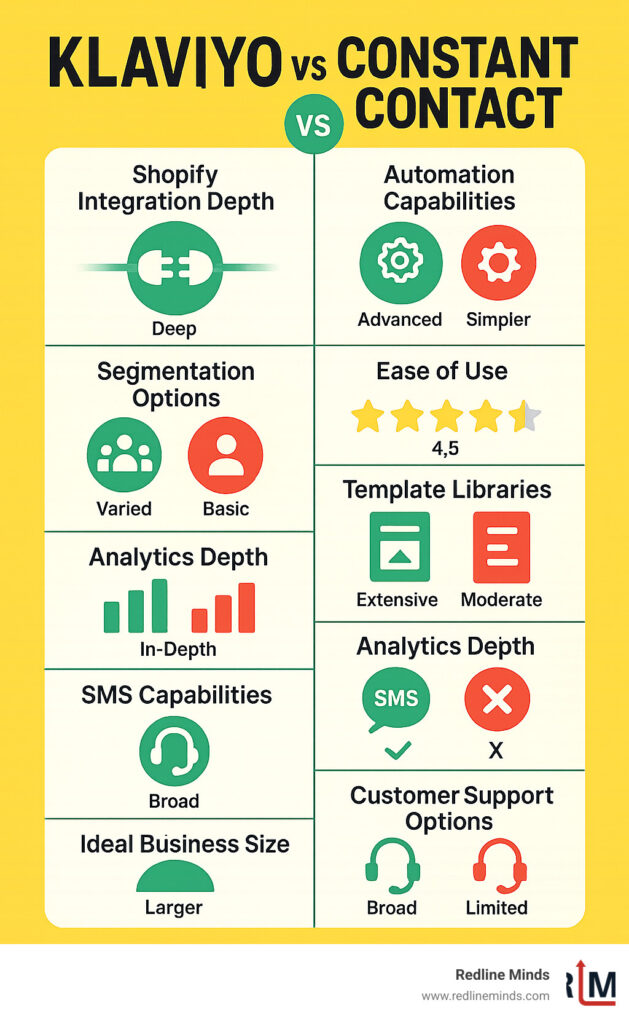
Shopify Email Marketing Platforms: Quick Comparison Dashboard
Choosing between email marketing platforms for your Shopify store doesn’t have to feel overwhelming. Our comprehensive comparison dashboard gives you the clarity you need to make an informed decision about which platform aligns best with your business goals and technical capabilities.
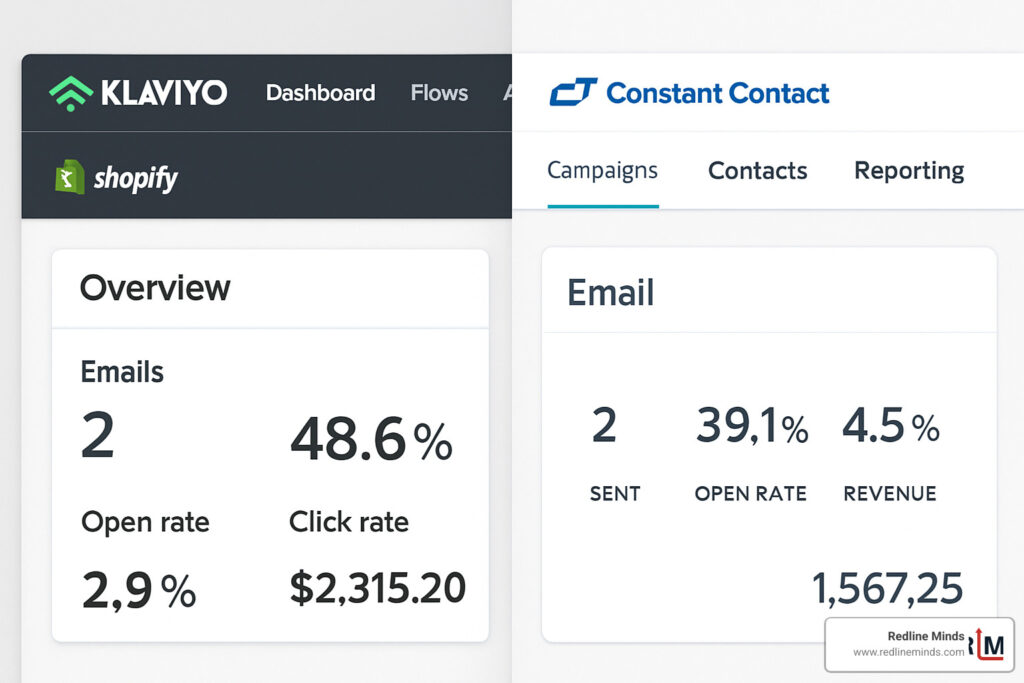
When evaluating email marketing platforms for Shopify, you’ll want to consider these essential features that can make or break your email marketing success:
| Feature | Advanced Platform | Entry-Level Platform |
|---|---|---|
| Shopify Integration | Deep native integration with real-time data sync | Basic integration with limited real-time capabilities |
| Automation Depth | 60+ pre-built flows; advanced conditional logic | Multiple plug-and-play templates; limited branching |
| Segmentation | Hyper-targeted behavioral & predictive segments | Basic demographic & engagement segments |
| Ease of Use | 8.7/10 (G2); steeper learning curve | 8.4/10 (G2); more intuitive for beginners |
| Analytics | Advanced revenue tracking & attribution | Basic open/click reporting with limited revenue data |
| SMS Marketing | Integrated SMS with a unified customer view | Limited SMS capabilities |
| Best For | Growing/scaling Shopify stores | New Shopify merchants & small businesses |
The numbers tell a compelling story. One of our Shopify clients shared their experience after switching platforms: “We saw a 140% increase in email-attributed revenue after migrating to an advanced platform and implementing their abandoned cart and post-purchase flows.” This real-world result highlights just how significant the right platform choice can be for your bottom line.
While advanced platforms offer deeper integration and more sophisticated marketing tools, entry-level solutions provide an easier entry point for merchants just getting started with email marketing. Your decision should align with both your current capabilities and your growth aspirations.
The best platform isn’t necessarily the one with the most features—it’s the one that best serves your specific business needs, technical comfort level, and customer engagement strategy. The dashboard above helps you visualize these differences at a glance, making your decision process smoother and more confident.
Shopify Integration, Ecommerce Features & Automation
When it comes to connecting your email marketing with your Shopify store, the depth of integration makes all the difference in your marketing effectiveness. The comparison between different email marketing platforms for Shopify reveals significant differences in how these platforms tap into your store’s valuable data.
Advanced ecommerce platforms have earned their reputation as integration champions for Shopify merchants. Their connections run deep, pulling in real-time data that transforms how you can communicate with customers. Your store’s product catalog, customer behaviors, and purchase history all flow seamlessly into these platforms, creating a complete picture of each shopper’s journey.
“The moment a customer adds something to their cart, sophisticated platforms know about it,” explains one merchant who saw their email revenue double after switching platforms. “This lets us send perfectly timed messages when interest is highest.”
Entry-level platforms offer more straightforward Shopify connections that handle the basics well. While they successfully import your products and customers, they don’t track the granular behaviors that power truly personalized marketing. The integration works, but lacks the real-time responsiveness that can make the difference between a recovered cart and a lost sale.
The automation capabilities flowing from these integration differences tell an important story. With deeper data access, advanced platforms enable more sophisticated workflows that respond intelligently to customer actions. Simpler platforms provide essential automations but with less behavioral intelligence behind them.
How Leading Shopify Email Platforms Handle Real-Time Data Sync
The speed at which your email platform processes Shopify data directly impacts your marketing agility. When a customer abandons their cart, waiting hours for that data to sync could mean missing your chance to recover the sale.
Advanced platforms’ approach to real-time sync uses webhooks and API connections that create an almost instant flow of information. When a customer browses a product, adds to cart, or completes a purchase, this data appears in their profile within minutes, allowing for timely, relevant messaging.
Customer profiles in sophisticated platforms become rich repositories of behavior, constantly updating as shoppers interact with your store. This creates a dynamic foundation for personalization that evolves with each customer touchpoint.
Entry-level platforms take a more measured approach with periodic batch updates rather than continuous synchronization. While functional, this creates slight delays between customer actions and your ability to respond to them. For many smaller stores, this delay may be acceptable, but growing merchants often find it limiting as they scale their marketing efforts.
Must-have Automations for Shopify Success
No matter which platform you choose, certain automated email sequences are essential for driving revenue while saving you precious time. These “set and forget” flows become your 24/7 sales team, nurturing relationships even when you’re focused elsewhere.
The welcome series forms customers’ first impression of your brand. Advanced platforms enable sophisticated welcome flows with branching paths based on how subscribers engage, while simpler platforms offer streamlined sequences that get the job done with less complexity.
Abandoned cart recovery emails are perhaps the most valuable automation for any Shopify store. Sophisticated platforms’ cart recovery flows include multiple touchpoints with dynamic product images that update automatically, personalized recommendations, and smart timing. Entry-level platforms provide effective but simpler abandonment emails that recover revenue with less customization.
Browse abandonment flows reconnect with shoppers who viewed products but didn’t add to cart—a powerful but often overlooked opportunity. Advanced platforms excel here with detailed tracking of exactly which products interested each visitor.
The journey doesn’t end at purchase. Post-purchase flows build loyalty, encourage reviews, and drive repeat business. Both types of platforms offer these sequences, though advanced solutions’ ability to branch based on specific purchase details (like product category or order value) creates more personalized follow-ups.
Finally, win-back campaigns help recapture dormant customers before they’re gone for good. These automated sequences target shoppers who haven’t purchased in a specific timeframe, with sophisticated platforms offering more nuanced targeting based on purchase history and engagement patterns.
More info about Must Have Email Automation Flows for Ecommerce
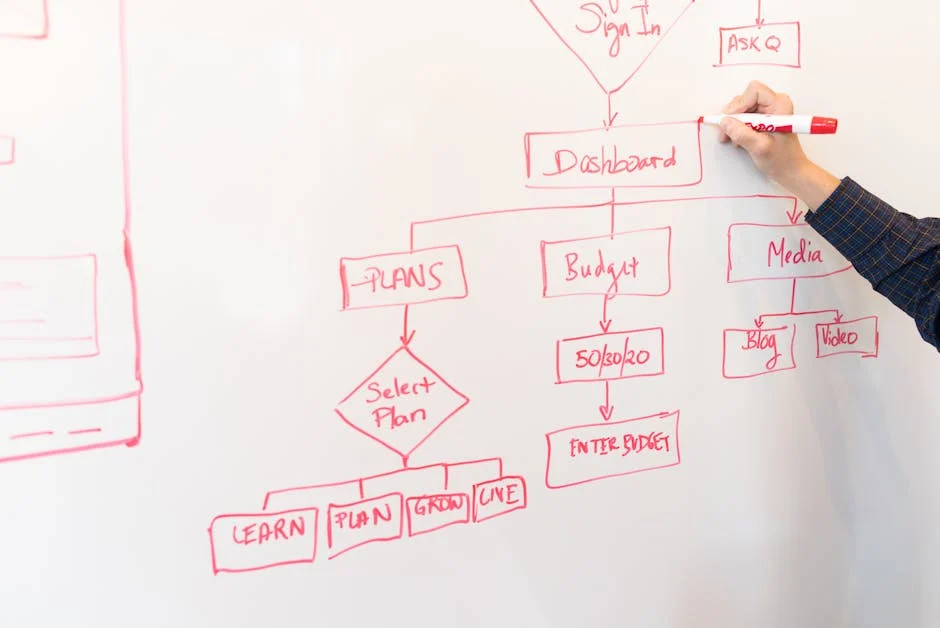
Segmentation, Personalization & Design Flexibility
When it comes to reaching the right customers with the right message, the gap between different email marketing platforms for Shopify becomes particularly evident. Your ability to slice and dice your audience into meaningful segments can make or break your email marketing ROI.
Advanced platforms shine brilliantly in the segmentation department with capabilities that feel almost mind-reading at times. You can create segments based on exactly how customers interact with your store, not just what they’ve purchased, but what they’ve browsed, how recently they visited, and how much they typically spend. Their predictive analytics can identify which customers are likely to become your VIPs and which might be slipping away before they’re gone.
“The Define with AI feature in sophisticated platforms is like having a data scientist on your team,” one merchant told us. “I can type something like ‘show me customers who viewed winter boots but didn’t purchase in the last 30 days’ and it builds the segment automatically.”
Entry-level platforms, while more straightforward, offer simpler segmentation tools that many beginners find approachable. You’ll get basic list-based segmentation and some behavioral triggers, but you won’t find the depth of predictive capabilities or automatic segment updates that advanced platforms provide.
The personalization story follows similar lines. With sophisticated platforms, you can show products unique to each customer’s browsing history, create personalized discount codes that are unique to each recipient, and build emails where entire sections appear or disappear based on customer attributes. Simpler platforms give you the basics—name personalization and some dynamic content—but lack the conditional sophistication that can make emails feel truly custom to each recipient.
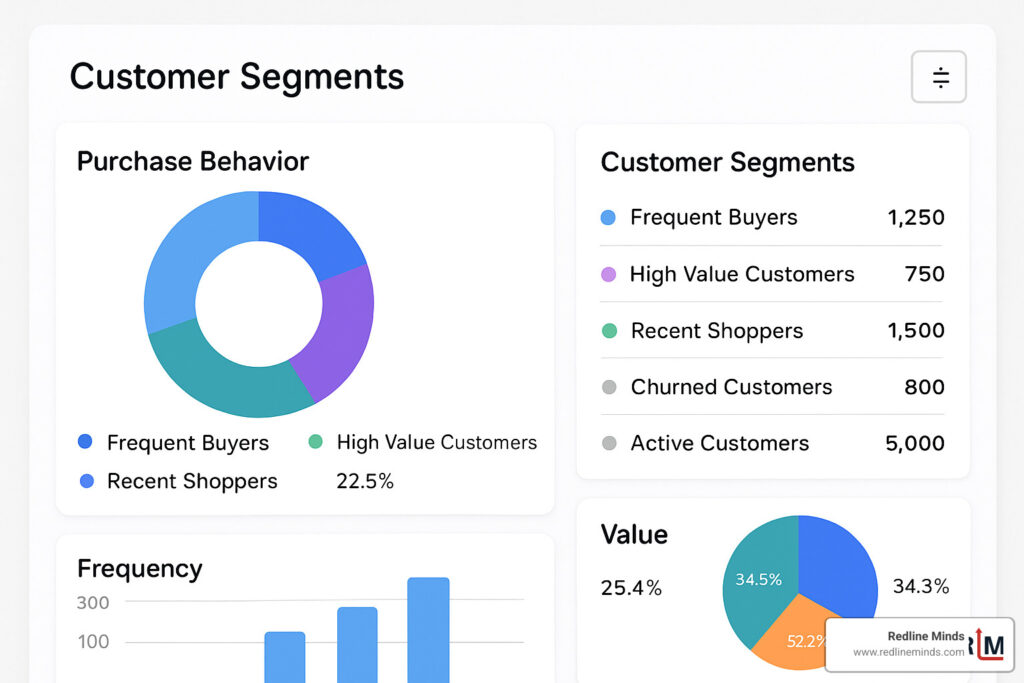
Advanced Flows: Opening Shopify Email Potential
The real magic happens when sophisticated segmentation meets advanced automation flows. This is where premium platforms create significant daylight between themselves and entry-level solutions for serious Shopify merchants.
Advanced platforms’ hyper-segmentation capabilities let you target customers with surgical precision. Imagine automatically sending different product recommendations to customers who browse your winter gear versus those looking at summer items. Or adjusting message timing based on when individual customers typically open emails.
The product recommendation engine in sophisticated platforms doesn’t just suggest random items—it learns from your store’s actual purchase patterns. It can identify products frequently bought together, recognize category preferences, and even notify customers when items they previously viewed are back in stock.
The conditional logic within advanced flows feels almost like having a conversation with your customers. If someone clicks on men’s shoes in your email, your next message can focus exclusively on that category. If they don’t open for a week, you can automatically switch to a different subject line approach.
As one Shopify merchant put it: “With advanced triggers, we set up a flow that reminds customers to reorder consumable products based on when they typically run out. Our replenishment sales increased 32% in the first quarter.”
Entry-level platforms offer more basic automation capabilities that work well for straightforward campaigns, but you’ll find yourself bumping against limitations when trying to create truly personalized customer journeys.
Email Design & Template Options
Your email design directly impacts how customers perceive your brand, and different platforms offer different approaches to helping you create beautiful emails.
Advanced platforms’ template libraries feel built specifically for ecommerce, with sections designed to showcase products in their best light. Their saved sections feature is a huge time-saver—create your perfectly branded header once and use it across every campaign. The mobile-responsive blocks ensure your emails look fantastic whether opened on a desktop, phone, or tablet.
What truly sets sophisticated platforms apart is how deeply they connect with your Shopify store. Their dynamic product blocks pull images, descriptions, and pricing directly from your catalog, updating automatically if you change anything in Shopify. Their AI content assistant can even help craft subject lines and email copy that match your brand voice.
Entry-level platforms provide a user-friendly drag-and-drop editor that many beginners find intuitive. While their template libraries are extensive, they feel more general-purpose rather than ecommerce-focused. The product blocks work, but lack some of the seamless integration and dynamic updating that advanced platforms offer.
“We switched from a basic platform to an advanced one last year,” shared one boutique owner. “The difference in how we can showcase our products is night and day. Our emails now feel like an extension of our store rather than generic newsletters.”
For merchants who want their emails to feel like a natural extension of their Shopify store experience, the design capabilities and template options will be a crucial factor in deciding between different email marketing platforms for Shopify.
Pricing, ROI, Analytics & Growth Insights
When you’re weighing your options between email marketing platforms for your Shopify store, understanding what you’ll pay and what you’ll get in return matters tremendously. The pricing-to-value equation looks quite different depending on your business size and goals.
Both entry-level and advanced platforms structure their pricing based on subscriber count, with costs increasing as your list grows. While advanced platforms typically represent a higher investment upfront, many merchants find the advanced features justify the price difference through improved performance.
The true ROI conversation goes much deeper than just the monthly subscription fee. Smart merchants look at the complete picture:
How much revenue are your automated flows generating? Pre-built sequences like abandoned cart emails often pay for the entire platform many times over.
How much time are you saving? The hours not spent building emails from scratch or manually segmenting customers have real value.
Are you gaining actionable insights? The depth of analytics can dramatically impact your ability to make smart marketing decisions.
The analytics capabilities between these email platforms show significant differences that directly impact your ability to grow your Shopify business:
Advanced platforms provide detailed revenue attribution tracking showing exactly which emails drive purchases, performance benchmarking against similar businesses in your industry, and predictive analytics that forecast customer lifetime value. You’ll also get sophisticated flow performance analysis with clear revenue metrics, statistical significance reporting for A/B tests, and multi-touch attribution across your email campaigns.
Entry-level platforms deliver more straightforward analytics: basic open and click reporting, list growth metrics, simpler revenue tracking, and basic industry comparisons. These essentials work well for smaller stores or those just starting with email marketing.
According to G2 ratings, the platforms score 8.7/10 and 8.4/10 respectively for ease of use, suggesting that even the more feature-rich option maintains a relatively manageable learning curve despite its advanced capabilities.
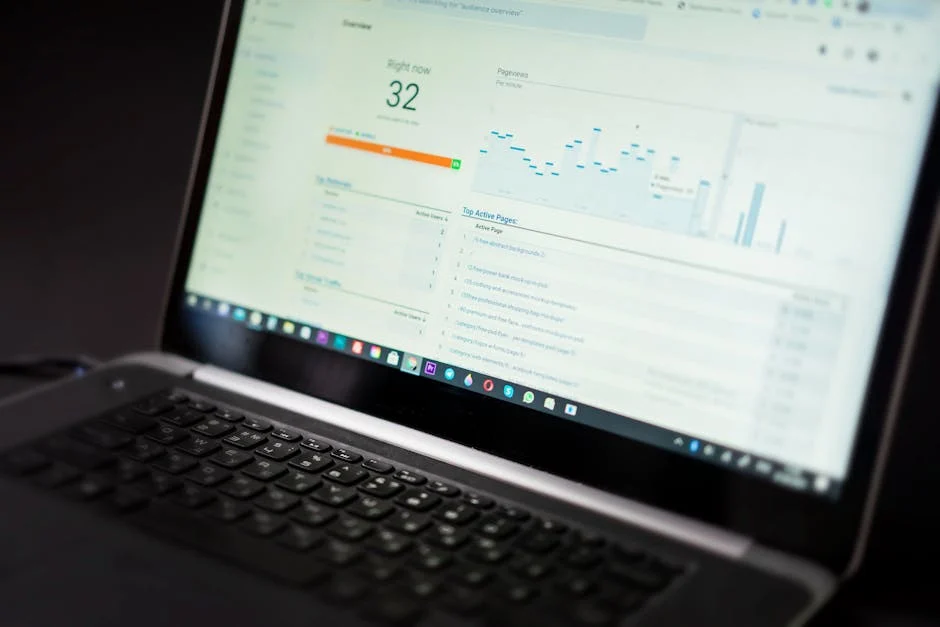
Support & Onboarding Resources
The quality of support and available learning resources can make or break your success with any email platform.
Advanced platforms offer live chat and email support, comprehensive academy training with certification programs, an extensive knowledge base, active community forums, and structured onboarding webinars. They also maintain a robust agency partner network for businesses needing professional assistance.
Entry-level platforms provide phone, chat, and email support, a basic tutorial library, community forums, and a simpler onboarding process that helps new users get up and running quickly.
G2 ratings show support quality scores of 8.5/10 versus 8.2/10, indicating slightly better support experiences from advanced platforms despite their greater complexity.
Calculating Lifetime Value Lift
One of the most powerful features in advanced email marketing is the ability to understand and improve customer lifetime value (CLV). Sophisticated platforms excel here with:
Predictive CLV modeling that analyzes purchase patterns to forecast future value
Detailed funnel attribution showing precisely which messages drive repeat purchases
Benchmark reports comparing your performance metrics against similar businesses
ROI calculators that project returns from specific campaigns and automation flows
As one Shopify merchant told us: “After implementing the recommended segmentation and automation strategies, we saw our average customer lifetime value increase by 27% within six months.”
Simpler platforms track immediate campaign performance effectively but provide fewer insights into long-term customer value development and predictive behaviors.
For more information about how different platforms structure their offerings, you can check out three pricing tiers for leading platforms include: or explore the scientific research on email analytics published by Shopify themselves.
Frequently Asked Questions about Shopify Email Marketing Platforms
Which platform is easier for new Shopify store owners?
When you’re just getting started with your Shopify store, the learning curve of your email marketing platform matters tremendously. The good news? Both leading platforms have put significant effort into user experience, though they take different approaches.
For those who value simplicity above all, the more straightforward interface of entry-level platforms wins out. Drag-and-drop editors with fewer advanced options mean you can get your first campaign up and running quickly, without feeling overwhelmed by possibilities. As one merchant put it so perfectly: “I was able to create and send my first campaign in under an hour, even with zero previous experience.”
Advanced platforms typically offer more powerful features but require a bit more time to master. You’ll find helpful tooltips, onboarding flows, and guidance built right into the interface, making complex tasks manageable once you grasp the basic workflow. Many merchants report that the initial investment in learning pays dividends through more sophisticated marketing capabilities.
What truly matters is matching the platform to your comfort level. If you break into a cold sweat at the thought of technical challenges, start with the simpler option. If you’re moderately tech-savvy and excited about powerful marketing tools, the slightly steeper learning curve of advanced platforms will likely feel worth the effort.
How do top platforms handle abandoned cart emails?
Abandoned cart recovery is the unsung hero of ecommerce email marketing, often delivering the highest ROI of any automated sequence. The differences between platforms in this crucial area can directly impact your bottom line.
The best abandoned cart solutions offer several key advantages:
Real-time triggering ensures emails arrive while purchase intent is still high, ideally within 1-2 hours of abandonment. Dynamic content displays the actual products left behind, complete with images, prices, and even inventory status. Multi-step sequences follow up strategically, with the ability to include personalized discount codes that increase in value if needed to secure the conversion.
More basic abandoned cart solutions still work, but with fewer bells and whistles. You’ll typically see simpler product displays, standard discount options that aren’t personalized to each shopper, and less flexibility in timing and conditional logic.
The results speak for themselves. One Shopify merchant shared: “After upgrading our abandoned cart system, our recovery rate doubled from 7% to 15% – that’s real money we were leaving on the table before.”
Pay particular attention to timing options. The most effective first recovery email arrives within hours of abandonment (when recovery rates peak), while platforms with less flexible scheduling might miss this critical window of opportunity.
What’s the best value option for a growing list?
As your subscriber count climbs, the value equation shifts. Both leading platforms increase their pricing as your list grows, but determining which offers better ROI requires looking beyond the monthly fee.
For smaller lists under 1,000 subscribers, entry-level platforms often provide better value, especially if you’re just beginning your email marketing journey. The lower entry point and straightforward interface let you achieve basic goals without overpaying for advanced features you might not yet need.
For growing lists over 1,000 subscribers, the more advanced capabilities of sophisticated platforms typically deliver superior returns despite higher costs. The advanced segmentation, automation, and analytics enable revenue generation that often significantly outpaces the additional investment. Many successful merchants report ROI of 30-40x when fully leveraging advanced capabilities.
Beyond list size, consider these value factors:
How deeply will you use advanced features? If you’ll only send basic newsletters, paying for sophisticated segmentation might not make sense. Your team’s technical comfort level matters too – powerful features deliver no value if they go unused due to complexity.
Your product margins and purchase frequency should influence your decision as well. High-margin products or frequent repeat purchases can justify investing in more sophisticated email marketing that maximizes customer lifetime value.
Many successful Shopify merchants follow a natural progression – starting with simpler tools and migrating to more powerful platforms as their business scales and their marketing sophistication increases. This approach lets you match your marketing capabilities to your actual needs at each stage of growth.
More info about Must Have Email Automation Flows for Ecommerce
Conclusion
When navigating the decision between email marketing platforms for Shopify, your perfect match depends on where your business stands today and where you’re heading tomorrow. Like choosing the right business partner, this decision should align with your current capabilities and future aspirations.
The right choice boils down to your unique situation:
Advanced platforms make perfect sense if your Shopify store has found its footing with consistent revenue and you’re ready to take things to the next level. Their powerful segmentation tools, revenue-focused analytics, and sophisticated automation workflows can transform your marketing effectiveness. While they require more investment—both financially and in learning time—these platforms deliver exceptional results for merchants willing to harness their full potential.
On the flip side, entry-level platforms shine for those just starting their email marketing journey. If you value straightforward tools, approachable templates, and a gentle learning curve, these platforms provide an excellent entry point. Many successful Shopify merchants begin here before graduating to more advanced solutions as their needs evolve.
At Redline Minds, we’ve guided countless Shopify store owners through this decision process. We’ve witnessed how selecting the right email platform, when properly implemented, can dramatically transform a store’s performance and growth trajectory.
Even the most sophisticated platform won’t deliver results without thoughtful strategy, compelling content, and continuous optimization. The tool is only as effective as the hands that wield it.
Before making your final decision, take time to document your must-have features, assess your team’s technical capabilities, and establish your budget parameters. This groundwork will guide you toward the option that best fits your unique circumstances.
Your email marketing needs will naturally evolve as your business grows. The perfect solution today might not serve you best a year from now. There’s no shame in starting simpler and upgrading as your sophistication increases—many successful merchants follow exactly this path.
Need a helping hand determining which platform will best serve your unique Shopify store? Our ecommerce specialists at Redline Minds can assess your specific needs and guide you toward the solution that will drive optimal results for your business. Explore our in-depth Shopify email platform comparison to learn more about how we can help implement the right platform for sustainable growth.